'The Lion King': Exclusive photos and intel from Disney’s rule-breaking beast of a remake
The elephant in the room is that there’s no elephant in the room. Or lion, hyena, or zebra, for that matter. In fact, it’s quite possible there are no indigenous African animals anywhere whatsoever within a 25-mile radius of this Playa Vista, Calif., production facility. And yet there are roars and squawks and grunts and growls, sounding out from any given corner of this secluded little studio, and if a visiting tourist knows where to look, they may even spot a majestic creature up onscreen with fur so fine, skin so textured, and eyes so exquisitely piercing that they’d bet their kingdom the animal was real.
The blurred lines of reality have never looked sharper than in Disney’s July 19 tentpole The Lion King, a summer blockbuster-in-the-making that refreshes a classic movie with a pioneering photo-real animation technology for a film experience that will be, simply, wild. As the latest animated Disney film to be reimagined for new audiences (in a string of “live-action” remakes that has earned more than $5 billion since 2010), The Lion King has put the Hollywood herd on high alert since the studio first announced its intent three years ago to remake the 1994 cartoon epic with director Jon Favreau. His successful adaptation of The Jungle Book wowed audiences in 2016, using cutting-edge tools to bring exotic animals to astonishing animated life (a technology that his collaborators at visual-arts firm MPC have only further developed since). But even Favreau would tell you: The jungle and the savannah are two vastly different beasts, and no beast roars louder than The Lion King.
Released in June 1994, the film remains the highest-grossing hand-drawn animated movie ever made. It was the No. 1 movie worldwide that year, Disney’s biggest-ever opening weekend at the time, and it would make pop culture history at the Oscars (winning for Hans Zimmer’s score and Elton John and Tim Rice’s ballad “Can You Feel the Love Tonight”), on stage (where the 1997 Broadway musical is, per Forbes, the most profitable entertainment property ever created), in stores (where the haul from total merchandise sales exceeded $1 billion in its first year alone) and even at cinemas again (when a 3-D re-release set a domestic theatrical record in 2011). The simplest explanation for its success is its story: a Hamlet-inspired, African-set fable of a young lion prince named Simba forced to fill the vast footprints of his late father, the fallen king Mufasa. It’s a heroic coming-of-age journey, epic in scope and universal in Western and non-Western culture alike — and while that certainly hasn’t changed 25 years later in screenwriter Jeff Nathanson’s adaptation, this lion cub is about to grow up in a whole new Africa.
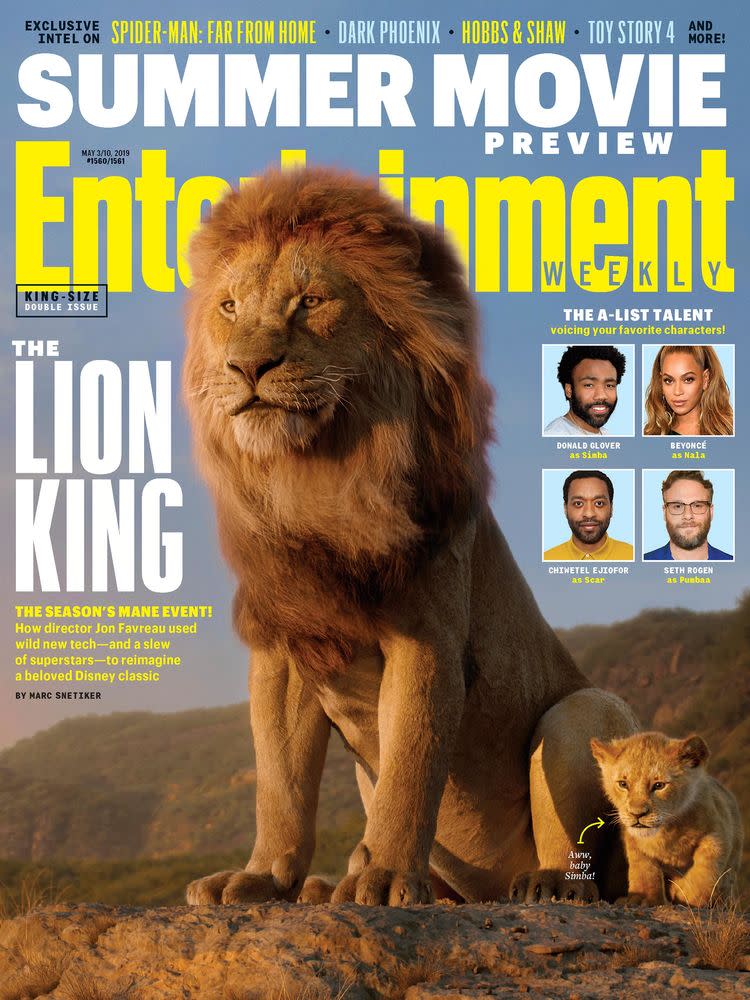
“It feels like we’re restoring a classic historic architectural landmark — how do you update it without changing the personality of it? How do you take advantage of all the new technological breakthroughs but still maintain the soul and the spirit of the original Lion King?” Favreau, 52, tells EW on set. “I think this film is a culmination of all the live-action adaptations that Disney has done of their animated classics. The idea of taking these characters and this music, just as the stage play took it, sticking closely to the story but reinventing it for a different medium… I thought that this technology would be separate enough from the animated film that it felt fresh and new, yet completely related to the original. And by the time Jungle Book was done, we had a lot of facility with this technology, so you’re hitting that part of your stride where you’re saying, ‘Now, what can I really do with this?’”
Much of the trailblazing technical team from The Jungle Book has returned for a second trip to the animal kingdom (plus a few new additions who geeked out from afar and pounced at the opportunity to join Favreau), but there’s one big caveat: Whereas Jungle Book counted a flesh-and-blood human (Neel Sethi as Mowgli) among its characters — hence, “live-action” — Favreau has no human star this time around. So despite what you may have heard about Disney’s “live-action Lion King,” be prepared to leave that label behind and acquaint yourself with the newest buzzy phrase in filmmaking: virtual production.
“By removing the one physical element of Mowgli, we were no longer tethered to the fact that we had to have blue screen or an actual set or real cameras, so everything became virtual at that point,” Favreau explains. “Once that gave us the freedom to operate without actually having to move through physical photography, it allowed us to open ourselves up to a whole new approach, and that’s why it feels different than Jungle Book. We’ve basically built a multiplayer VR filmmaking game just for the purposes of making this movie.”
Imagine it: To get to the Lion King set, simply pop on a virtual-reality headset like EW did way, way back in the summer of 2017. Look upwards and you realize you’re at the bottom of Pride Rock, the film’s majestic mountain centerpiece. Look down and you see your VR avatar, a little green humanoid… ball… thing. A few hundred feet above you, Favreau’s VR avatar (the same blob but blue) floats gracefully in the sky beside the summit of Pride Rock. Using the controller in your real-life hand, you eventually figure out how to fly up and join him, and suddenly there you are, suspended in the clouds alongside the director, watching a scene play out between two animated lions on the rocky, sun-drenched peak.
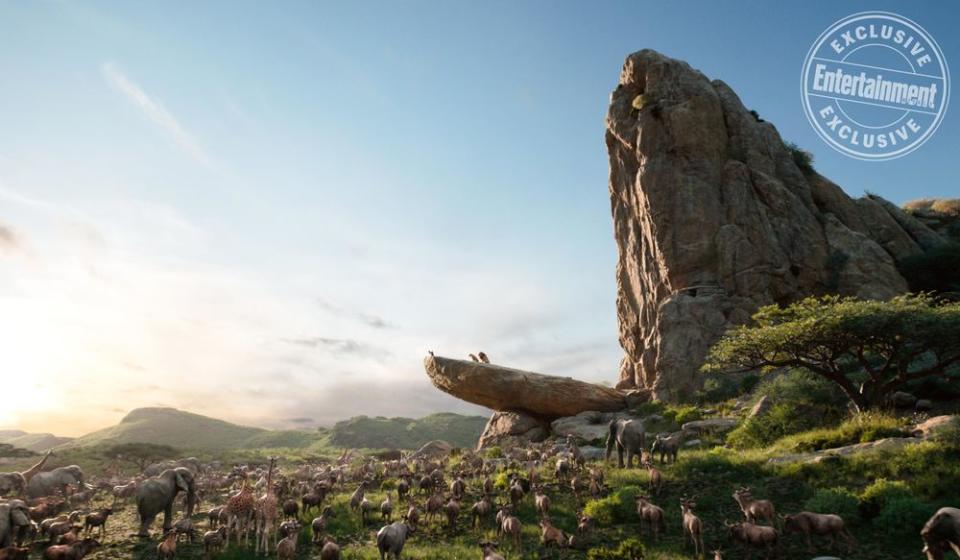
Animators have used keyframe CGI and the recorded dialogue of actors to create a rough master animation of today’s scene, in which Mufasa (James Earl Jones, reprising his 1994 role) teaches young Simba (JD McCrary) about the bounds of the kingdom he’ll one day inherit. While each “take” of the animated lions’ performance is the same, the VR technology has afforded Favreau the freedom to shoot the scene from any nook, cranny, or even mid-air vista view of Pride Rock. Every set piece, from shadowy elephant graveyards to lush romantic waterfalls, can be as freely explored as any open-world 3-D video game, allowing Favreau, his director of photography Caleb Deschanel, and the crew to scout locations together in real time in virtual reality. They can lay down camera positions and find their shots, just as they would on a physical set, only without having to relocate heavy camera units, chase the light of a dwindling sun, or coerce animal actors into doing their scenes once more with feeling. When “shooting” finally begins, camera movements are encoded onto video, and there’s even a little virtual video village where other crew members in the VR volume can watch what’s happening. It’s all to say: Save for the fact that everyone happens to be floating in the middle of the African sky, you’d swear this whole endeavor was just one craft-services table away from an actual movie set.
“The whole reason for all of this is to make an animated film feel live-action — to have a real crew come in, interface with an animated film, and make all the camera decisions that you would on set, instead of somebody sitting at a keyboard programming in the camera moves,” Favreau explains. “If you look at the way we’re covering and cutting [the animated performances], all of that is related to traditional cinema.” What the filmmakers are ultimately searching for is a marriage of state-of-the-art character animation with the kind of gorgeously gritty cinematography you might find in a nature documentary. Kinetic, impulsive camerawork capturing beautifully rendered animal behavior. An imperfect shot of perfect action.
“There are times when I follow the animal and it jumps and I miss the action and we have to do it again because I didn’t operate perfectly, and there are times when I didn’t operate perfectly and it looks even better,” says Deschanel, a 50-year cinematography vet. “Virtual reality is more a tool than the end result. You have to live in it, in a weird way, and feel what it’s like to be at Pride Rock in order to decide what you want to do and where you want to do it. But other than that, you really are doing exactly what you do when you make a movie.”
If it’s all still hard to visualize, then Favreau says hakuna matata. “The hope is that none of this will matter when people actually see it,” he concedes. “We hope it will feel like something different and something that’s as emotionally engaging as a film with real animals using real cameras. And as we introduce the material to people, they’ll begin to understand — or at least be confused in a way that’s creatively compelling.”
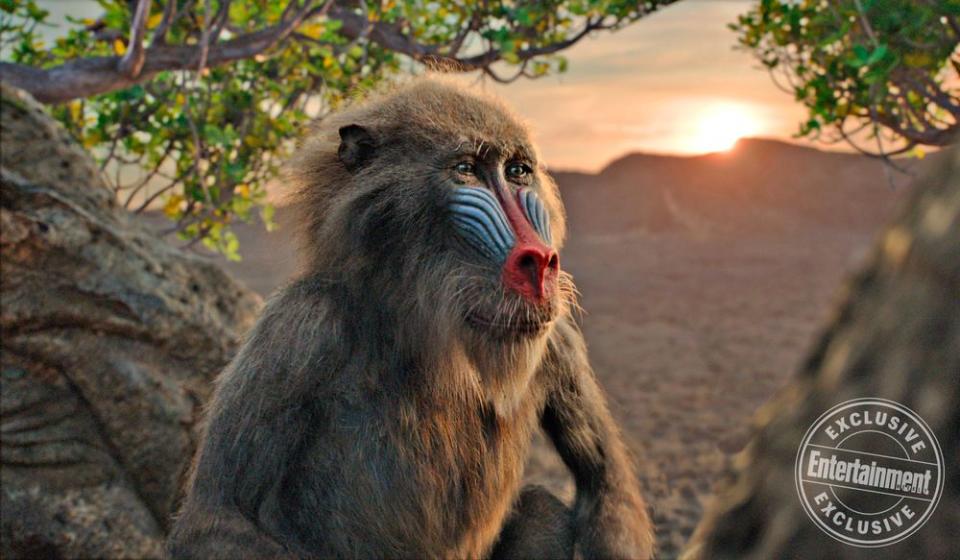
The thing is, you just can’t mess with The Lion King.
Not because of its quantifiable metrics or its grand Shakespearean undertones, but for the particular pristine nostalgia it holds among young and millennial audiences as a formative film that dealt with fatal themes. “I once heard it referred to as the crown jewel of the Disney movies, and for me at least, it’s for sure the one that hit me the hardest, that taught me the most lessons about life and death and many things in between,” says Seth Rogen, 37, who voices Simba’s non-worrying warthog pal Pumbaa. “Whenever Jon has shown me [footage], I weep uncontrollably because it does just hit a raw nerve in some ways and taps directly into these feelings from my childhood, but updates them with a scope that is heavily impactful to me as an adult.”
In that regard, Favreau’s cast and crew are filled with Seth Rogens: fervent, vocal fans who reminded the filmmaker of the production’s precarious locus at the intersection of hands-on visual reinvention and hands-off narrative preservation. Not that Favreau needed any reminding. “There are so many places you can’t go with this,” he declares — but can you teach an old lion new tricks? “It’s amazing how much you can change, but if you reference the proper memory points, it feels like you’re completely being true to what came before. The trick is to quantify those things. Figure out what those connection points are. There’s a checklist: ‘What do I expect to see if I go see this?’ And there were about six things on that list for Jungle Book.” Favreau chuckles: “This one has about 60.”
So the director tried to identify impactful opportunities where he could safely expand on the piece for modern audiences — for instance, in casting. “It’s almost like we’re relaunching a classic stage piece, casting it in a way that brings a new spin to it and makes it exciting and interesting,” he says. Favreau found his anchor in zeitgeist-shaking actor-musician Donald Glover, who leads the pride as adult Simba, a role he took at the onset of a star-making career stretch that included his hit FX series Atlanta, his quadruple-Grammy-winning song “This is America,” and his scene-stealing role in Solo. “[The Lion King is] a timeless story, but I think the way Favreau has constructed it, it’s a very timely story as well,” Glover, 35, tells EW. “I just wanted to be a part of a global good.”
Glover’s castmates have no lack of global reach among them, either: Music icon Beyoncé Knowles-Carter voices Simba’s betrothed, the powerful lioness Nala; comedy stars Billy Eichner and Rogen, whom Favreau tasked with modernizing the film’s humor, lounge and laze as the responsibly irresponsible Timon and Pumbaa; Oscar nominee Chiwetel Ejiofor brings his dramatic gravitas to the depraved black-sheep prince Scar; and the legendary James Earl Jones, at 88, booms once again in his role as king Mufasa. The ensemble also includes John Oliver as avian major domo Zazu, Alfre Woodard as queen Sarabi, John Kani as mystic mandrill Rafiki, and Eric André, Florence Kasumba, and Keegan-Michael Key as a reimagined trio of hyenas loyal to Scar.
Even the cast can’t believe the cast. “I think I screamed when I found out Beyoncé was going to be in the movie,” says Shahadi Wright Joseph, 13, who voices young Nala. “And when I found out she was going to be playing older me, I really had to step my game up and think about what Beyoncé would want.” McCrary, 11, who pads around the Pride Lands as young Simba, gushes, “Donald Glover is so talented that I actually did have to take it into consideration, because if Simba is going to grow up to be some sort of figure and you know of it, you have to keep that motive.” Ejiofor says of the towering Jones: “For those of us who grew up with James Earl Jones and his voice, the comfort of that is going to be very rewarding in taking us on this journey again. It’s a once-in-a-generation vocal quality.” Rogen raves of Knowles-Carter, “I was once shoved aside by her security guards backstage at the Grammys.”
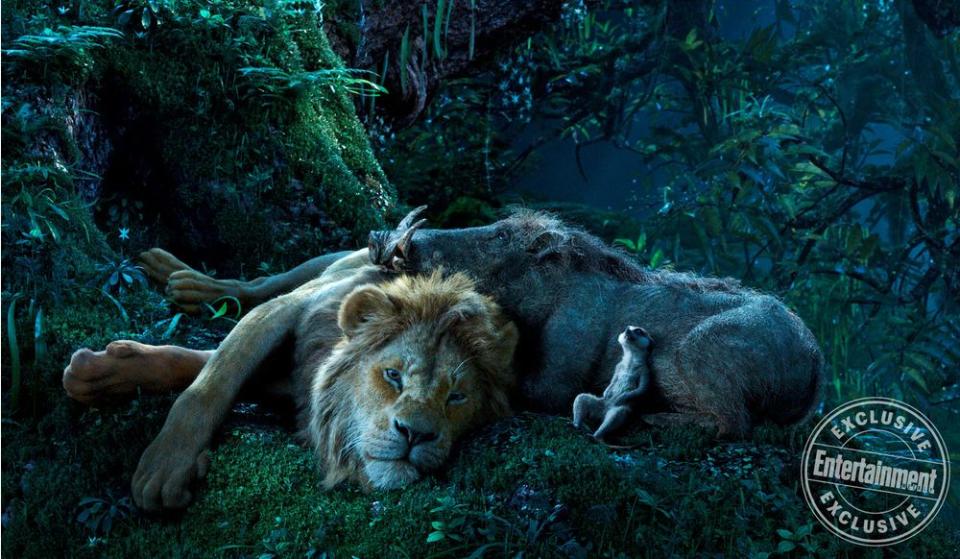
The characters themselves are just as formidable as the celebrities playing them. Names like Simba, Rafiki, Timon, and Scar have spent nearly a quarter-century etched into pop culture, and now presented a new batch of actors with a daunting yet thrilling opportunity to reinvent. “As an actor, I 100 percent don’t think I’m right for every role — there are a lot of roles I don’t think I’m right for even in movies I’m making — but Pumbaa was one I knew I could do well,” says Rogen, whom Favreau e-mailed with a casting offer shortly after the film’s announcement. “Truthfully, I probably would have been a little insulted if he didn’t ask me to.” Eichner was slightly less assured: “People way more famous and successful than me would have killed for this part. I’ve heard about some of them!” The actor, 40, counts Nathan Lane, the original portrayer of meerkat Timon, as a personal musical-comedy hero. “It’s such a great role that allows you to do so much,” says Eichner. “But I’ve learned that the bigger the project and the bigger the names that you’re working with, the more you have to ignore it. If you get to the soundstage and you’re thinking, ‘Oh my God, what a full-circle moment! Nathan Lane did it originally! Beyoncé’s in this!’ then you’re paralyzed creatively. You just have to put that out of your head in order to get the job done.”
Yet for a star of Beyoncé’s stature, the scrappy black-box stage of The Lion King may arguably be the most intimate she’s performed on in years. “Although her persona onstage is bigger than life, she’s very down to earth and is very much dedicated to having a life that is human-scale,” says Favreau, who reached out to the singer on the whim that she might be interested in playing Nala. “I think that part of [her joining the film] is that she’s got young kids, part of it is that it’s a story that feels good for this phase of her life and her career, and she really likes the original very much. And then, of course, there are these wonderful musical numbers that she can be involved with, and my God… she really lives up to her reputation as far as the beauty of her voice and talent.”
Favreau earmarked the film’s music as its other major arena ripe for renewal. With all five songs from the 1994 film (including “Be Prepared” and “I Just Can’t Wait to Be King”) featured again, he hoped to spark collaborative magic by reuniting the original music team of Zimmer, John, Rice, and arranger Lebo M. to revisit their work alongside the new influences of Childish Gambino and Mrs. Carter. Favreau notes, “[One thing] I didn’t do for Jungle Book is double-down on the music and find people who were going to reinterpret this and bring something new and fresh to it. Each iteration of The Lion King seems to bring its own spin to the music while still feeling related to what we all connect to as The Lion King. And so having Donald Glover and Beyoncé involved, not trying to create new songs but trying to build on what people remember and love about the old ones, has been really fun and formative.”
Zimmer, faced with reevaluating his Oscar-winning score, was initially hesitant to return. “I have worked very hard to not ruin things through improvement,” he tells EW. But as he performed the music of The Lion King (with Lebo M., no less) during his live concert tour over the past three years, he began to understand his role in this circle of second-life. “We had been playing the same notes, but we were playing them differently, putting all our emotion, all our humanity into it — we weren’t playing a movie. And so I suddenly realized what my place in this new version was: to try a big experiment and use my band and orchestra, go back to Africa, work with Lebo and the chorus and extraordinary musicians from all over the world, and really make this a performance,” says the composer, 61. “What I can ultimately do is add that energy, add that passion, and add that nostalgia, all without changing the notes too much. I’m being truthful to the ambitions that I didn’t quite manage to achieve the last time around. At the same time, it means so much to people, [so] the only thing I can offer them is to put my heart into it and make it a celebration. Make it shine, make it joyful, make it emotional, make it an experience. If there is one story or film in the world that I can think of at this very moment in time that can lend itself to truly becoming an experience, it is this.”
At least on the back-end, the 2019 experience has already shown itself to be markedly different for alumni of the 1994 film, which was famously underestimated even up to its release by Disney suits who considered it a genre-confusing, princess-less B-project, second in priority to Pocahontas. “We didn’t know we were working on a phenomenon,” admits Zimmer. “But we were playing and writing about the things that mattered to us. We had no commercial thought in our head at all — and I’m treating this version absolutely the same way. I am doing this strictly for the people for whom it means something. I’m working my musicians to the bone because I want to get that performance. I want to smell sweat and blood in this studio.”

An argument is not just an argument — and a scene is not just a scene — when it’s between two ferocious lions. “There’s something quite interesting in knowing that you’re always holding a lethal capacity,” muses Ejiofor, 41, who describes his diabolical version of Scar as more “psychologically possessed” and “brutalized” than the cartoon counterpart. “Especially with Scar, whether it’s a vocal quality that allows for a certain confidence or a certain aggression, to always know that at the end of it you’re playing somebody who has the capacity to turn everything on its head in a split second with outrageous acts of violence… that can completely change the temperature of a scene.” But incisors notwithstanding, Favreau’s actors were directed to eschew any presuppositions about animal behavior and treat their beasts as humanely as humanly possible — a relief, for some. “I wasn’t sure if I was going in there and, no pun intended, hamming it up,” says Rogen. “The physicality of Pumbaa is so unanalogous that it thankfully just did not seem like me crawling around on all fours was the best idea. Also, I was lying, pun was intended.”
All things animal were left in the paws of Favreau’s animators. Each scene began with Favreau directing the actors in a black-box theater rigged with microphones like a live sitcom taping (except Jones, who recorded his part in a studio in New York). Those sessions became the actual vocals used in the film, and any camera footage became a reference for the animators to translate the performers’ motions — expressions, gestures, distances, hesitations — into animal equivalents. “All those little subtle cues that actors give, animals have their version of, so what a human would do with its face, a lion might do with its whole body,” Favreau expounds. Master animations were created for each story beat, which would then be loaded into the VR volume and shot (see: paragraph 8), at which point the actors had the chance to enter the virtual stage and see how their scenes were progressing (and, per Favreau’s signature belief in iteration, take any potential stabs at re-recording).
“It was really amazing,” Glover says of the director’s techniques. “I’ve never seen anything like it. To be able to have that type of mobility in an actual world is the first of its kind, I think. How he melded new and old tech was really inspiring.” Ejiofor adds, “I’m sure he had to do this with everybody — you would spend the first 25 minutes of a session just talking with Jon about how all of this was being achieved. The technology just seemed so next-generation and out there. But to know that an audience is going to be experiencing something that is absolutely brand new, that has never been seen before, and thereby is able to connect to and engage with the story in this totally unique way is, to me, an extraordinarily exciting thing to be a part of.”
Perhaps just as significant was the simple act of actors recording together — a rarity in animation, but one that can help actors unlock key character dynamics, like with Timon and Pumbaa. In The Lion King’s translation from colorful cartoon to NatGeo docu-chic, it’s Eichner and Rogen as the film’s comic relief who embody the project’s complex mission of calibrating a proper tone for a photo-realistic production. “The aesthetic style of this movie is so wildly different from the original that there are certain aspects of that type of voiceover acting that Nathan Lane and [original Pumbaa] Ernie Sabella did which would, as great as it is, simply feel completely out of place in this version, which is not to say that we don’t nod to it here and there where we can, but we didn’t lean into that style quite as much,” says Eichner. “Nathan and Ernie were literally coming out of a legendary production of Guys and Dolls on Broadway, which I saw as a kid, actually, and they really leaned into that old-school, vaudeville, Borscht Belt-inspired sensibility for Timon and Pumbaa. Seth and I are obviously not coming out of a production of Guys and Dolls, but I think overall our dynamic is a bit more conversational. I’m not saying it’s subtle, but it is conversational.” (Rogen equates the Timon and Pumbaa relationship to something more akin to marriage: “They’re very, very, very close friends, and like any two people who spend a lot of time together, they start to have things that bother one another about each other. Like, meerkats are very quick, fast-paced animals, and warthogs are… a little on the slower side.”)
Other characters needed no such reinvention. Favreau says Mufasa is the one character whose lines have changed the least from the original 1994 script, and that same general immunity applies to the actor voicing him. “James Earl Jones would do a take and then ask me for direction, and I honestly couldn’t give an answer! I was like, ‘You’re Mufasa!’ Everything he said sounded perfect because it was him saying it,” recalls the director, who even now in post-production still can’t quite believe that Jones agreed to revisit Mufasa’s old stomping grounds. “He could have just as easily said no. His voice could have sounded different. There’s a lot of ways this could not have worked out. And that all of the stars aligned and there I was listening to him record… I felt something very powerful happening. It felt like a very significant milestone when we recorded him, and it was hard to not feel like an audience member. Even for me as a filmmaker, it’s very hard to do your job during those moments when you just get lost in it.”
***
If the stars aligned for the first Lion King, those luminary ladies seem to be getting back into formation. Early prognosticators are tracking the four-quadrant film to be one of the, if not the, biggest of the year (in the company of heavyweights like Avengers: Endgame, Frozen 2, Toy Story 4, and a Star War, no less — all Disney, of course). But the intangible aftereffects of Favreau’s film stand to be just as striking.
There’s a cultural impact to be had, as Glover, Ejiofor, and others in the ensemble agree that the casting of predominantly black actors adds a powerful dimension to a piece that, in 1994, found its African princes in Matthew Broderick and Jonathan Taylor Thomas (no shade, but still). “The Lion King is a wonderful opportunity to bring in a cast of black actors to play these extraordinary iconic roles,” says Ejiofor. “Obviously I feel very connected to anything African because of my heritage and that’s why it’s a very special experience to me. It’s wonderful that both Jon Favreau and Disney have really pushed to engage with that kind of casting.” Wright Joseph adds, “Representation is really important because you have all of these amazing characters inspiring little black girls and black boys. I [know] Nala inspires little girls because that happened to me when I was younger. I literally said that I wanted to be her. She’s a great role model.”
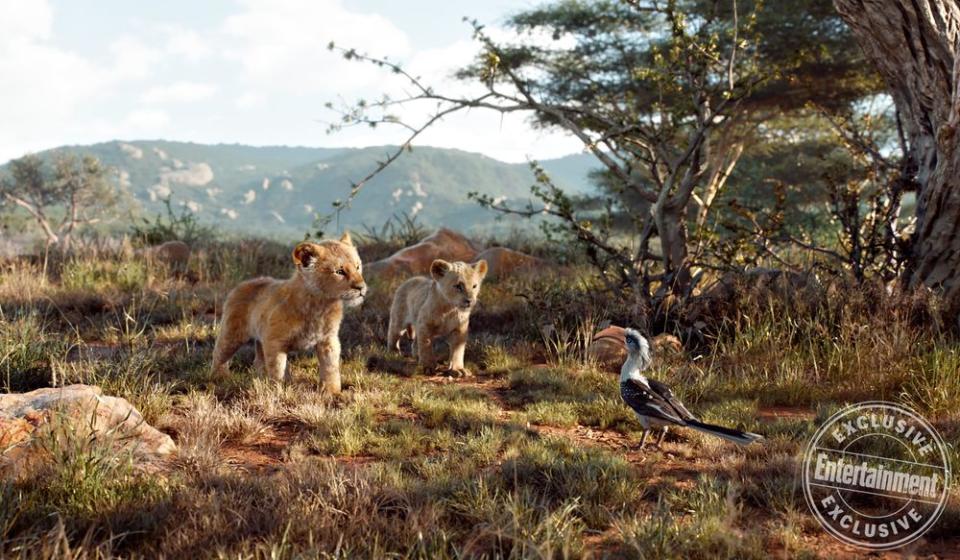
The moviemaking community may also feel the floor rumbling as Favreau decisively breaks ground with new technology. Industry leaders Magnopus, Vive, Oculus, Unity, and others have lent crucial assists in The Lion King‘s virtual production; the concept itself has been bandied about for several years now, but veterans on The Lion King’s team compare the potential filmmaking disruption of a fully-realized virtually-produced feature to that of James Cameron’s Avatar (which some of them even worked on in 2009). Alumni of The Jungle Book, too, dubbed a game-changer just three years ago for blurring the lines between artifice and authenticity, acknowledge how they’ve topped themselves here. “The time was ripe to do this, but no one was doing it,” says production visual effects supervisor Robert Legato, a three-time Oscar-winner. “This was a push to make a film that broke the conventions of what you’d imagine these types of films could be, and it’s just literally force of will. You choose to make a movie one way and if the result happens to be good, you can see how you can apply it to other things, and that’s not as common as you’d think. Everybody does VFX movies, everybody does animated movies, everybody does live-action movies—but to mix all of them together to make something that belies how it was done is, I think, the game-changing portion of all this.”
In some ways, that’s where this newfangled Lion King, for all its hornbills and whistles, might feel right at home under the classic Disney banner: Walt, famous for his insatiable obsession with cutting-edge technology, likely would have been the first to enter the VR volume every morning and the last to take off his headset each evening, while outside the virtual space his legacy of family storytelling lives on. “Isn’t this how we’re supposed to spend our lives? Aren’t we supposed to try to do excellent things and have a good laugh while we’re doing them?” says Zimmer. “Since we did The Lion King the first time, look how the music business has fallen apart. We’re never going to get our six-platinum album for this anymore. We’re truly not doing it for the money. We’re not doing it for the record sales. We’re doing it because we have to. Because we have to give back to this audience that has supported this story all these years.”
And history would suggest that The Lion King, both ancestor and infant heir, can expect a long reign ahead yet. “Seth and I looked at each other early on and said, ‘No matter what else we do in our lives, more people around the world for years, decades, maybe centuries to come will hear our voices in this than they’ll see us in anything else we ever do,” says Eichner. “Long after we’re gone, this movie will be seen by children who haven’t even been born yet. So all you can really do is sit back and laugh at the absurdity of how enormous it is.”
Enormous. Revered. Impossible to forget. Ahh, there’s that elephant.
For more on The Lion King and other upcomingsummer movies, pick up the new issue of Entertainment Weekly on stands Friday, or buy it here now. Don’t forget to subscribe for more exclusive interviews and photos, only in EW.
Related content:
Meet the cast of Disney’s live-action Lion King
The Lion King trailer gives us Scar, Timon, Pumbaa, and more
The Lion King puts Mufasa front and center in new poster

